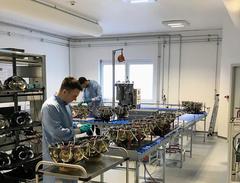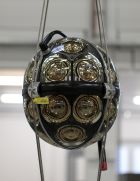URL: https://www.desy.de/news/news_search/index_eng.html
Breadcrumb Navigation
DESY News: First sensors for IceCube Upgrade on their way to Antarctica
News
News from the DESY research centre
First sensors for IceCube Upgrade on their way to Antarctica
The upgrade of the IceCube neutrino telescope has reached an important milestone with the shipment of the first 128 sensors built at DESY to Antarctica. The IceCube detector consists of more than 5000 light sensors, known as Digital Optical Modules (DOM), which are melted into the ice of the South Pole at a depth of up to 2500 metres on 86 cables. It is the largest neutrino telescope in the world with an active volume of around one cubic kilometre. Since its completion in 2010, IceCube has detected high-energy neutrinos from cosmic accelerators such as active galactic cores and from our own Milky Way galaxy. The particles were up to 100 times more energetic than the protons in the Large Hadron Collider, the world´s largest accelerator.

Zeuthen mechanics assemble the mDOMs under clean room conditions. Photo: DESY, Matthias Schust
As it is with the IceCube detector itself, DESY is significantly involved in the IceCube Upgrade project. Together with German university groups, the researchers in Zeuthen developed one of the two sensor types for the upgrade: the multi-PMT Digital Optical Module (mDOM). “We are very pleased with the successful progress of the upgrade project – from development and production to the current dispatch of the first modules,” says Christian Stegmann, DESY Director of Astroparticle Physics.

The mDOMs newly developed for the IceCube upgrade can look in all directions with their 24 light sensors. Photo: Susann Niedworok
“This marks an important milestone on the way to the IceCube Upgrade. The entire mDOM team is already looking forward to the first neutrinos measured with mDOMs,” says Timo Karg, who is leading the work on the IceCube Upgrade at DESY. The mDOMs will travel by ship to New Zealand and from there be transported by plane to the South Pole. There they will be tested by DESY scientists next December and January, during the Antarctic summer, and will then be ready for installation in the ice a year later.




